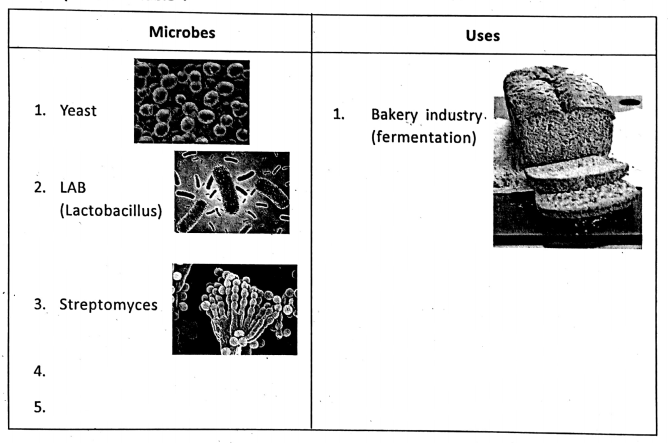Chapter 1 Interdependence Of Organisms And The Environment Man And Other Animals Depend On Plants
Our family and our society:
Human beings are the most intelligent organism in earth. Yet we can not live alone. Not only we but no animal or plant or any other organism can also live alone.
An organism (Animal, plant, or microbes) lives in a group or a single (solitary), or whether the organism form a society or not, all the organisms have to depend on others directly or indirectly.

You must have noticed that your father or some other person calls a doctor when someone of your family member is ill, call a plumber to repair water pipe connections, or call an electrician. For any electrical problem in the house. Different persons are engaged for different types of jobs.
Read and Learn More WBBSE Notes For Class 6 General Science and Environment

Where you go when your cycle do not work properly?
Moreover, you have also noticed that in your family mother or any elderly woman or any other person does the work of cooking. Father, uncle, mother or grandfather performs the work of daily marketing.
“WBBSE Class 6 General Science Chapter 1 interdependence of organisms and environment notes”
Therefore, it is clear that all of us to depend on others for our existence in the family and in society. It is also clear that we can not do all these works ourselves alone.
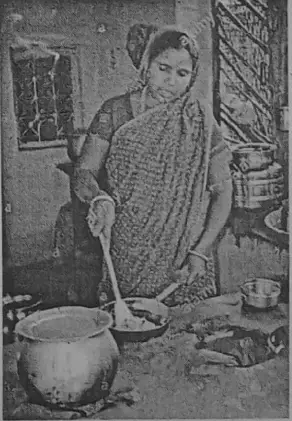
In the living world, animals depend on other animals and plants for their food, shelter, oxygen, reproduction, body defense, development, etc. Plants also depend on animals too for carbon dioxide (CO2 ), pollination, dispersal of fruits and seeds, reproduction, growth, etc.
| Class 6 History | Class 6 Social Science |
| Class 6 Geography | Class 6 Science |
| Class 6 Maths | Class 6 Science MCQs |
| Class 6 General Science | Class 6 Maths Solutions |
| Class 6 Geography | Class 6 Hindi |
So in the living world animals and plants are interdependent :
Prepare Two Table-
- For which work we need help from family members and
- From other members of our society.
Family Work:
| Type off work | Whom to depend upon/performer |
| 1. Daily household cooking | 1. Mother, aunt, or some other person |
| 2. Washing and cleaning | 2. Mother or any person keep for this work |
| 3. Looking after children | 3. Mother, grandmother |
| 4………………………… | 4………………………… |
| 5………………………… | 5………………………… |
| 6………………………… | 6………………………… |
Help from others Outside the family
| Type of work | Whom to depend upon/performer |
| 1. Electrical repairing | 1. Electrician |
| 2. Plumbing problem | 2……………….. |
| 3. Sweeping and cleaning | 3……………….. |
| 4…………….. | 4. Physician./ Doctor |
| 5 | 5 |
How do we depend upon plants for our survival?
If you carefully observe around, you will find so many things that we depend upon come from plants.
Complete the table mentioning the plant products/objects:
| Column l | Column-ll |
| Products | Plant/Plant parts |
| For Food | |
| 1. Rice | 1. Paddy/ seed and fruit |
| 2. Wheat | 2. ……….. |
| 3. Bazra | 3. ……….. |
| 4. ………… | 4. ……….. |
| Household goods (wooden) | |
| 1. Furniture | 1. Wood from trees |
| 2. | 2. ………………. |
| 3. | 3. |
| Building materials | |
| 1. Cori / Borga | 1. ……….. |
| 2. Pillar | 2. ……….. |
| 3. | 3. ……….. |
| Cloths | |
| 1. Fibres | 1. Cotton |
| 2. | 2. ……….. |
| Medicine | |
| 1. Quinine | 1. Bark of Cinchona Tree |
| 2. | 2. |
| 3. | 3. |
Not only man but other animals also depend upon plants in nature. Observe your surrounding and complete the table-

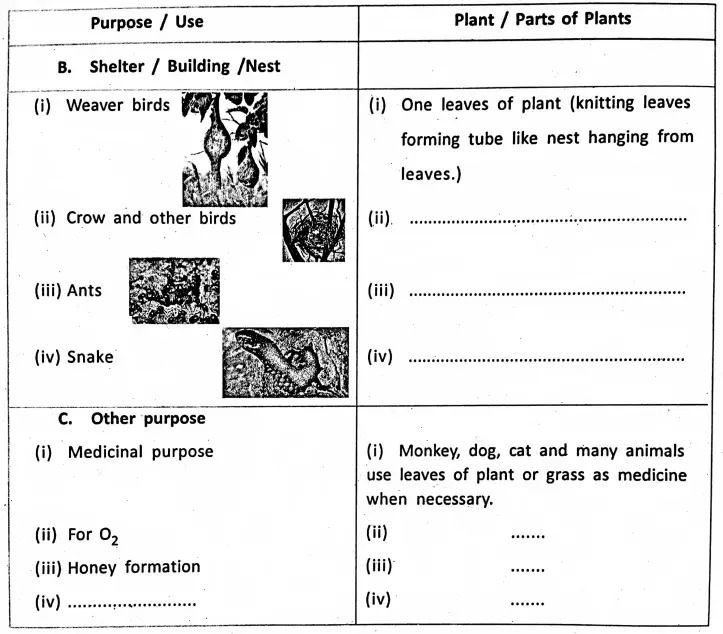
How Do Human Beings And Other Animals Depend Upon Plants
Dependence of animals upon plants.
From the above discussion, it has been more or less clear that human beings as well as other animals depend upon plants. But it is true that all the food products of animals are not directly come from plants.
Human beings and some other animals also get food from other sources-like other animals or their derivatives, such as we get milk from goats, cows, buffalo, camels, etc.,
“WBBSE notes for Class 6 Science interdependence of organisms and environment”
Eggs from different birds, meat from different animals such as goat, sheep, cow, chicken, goose, etc. The source of food of Carnivores (like tiger, lion, etc.) are animal. They do not take directly the plant or plant products.
They use other animals as their food who are usually depend upon the plant directly (herbivorous), such as deer, cow, goat, etc.
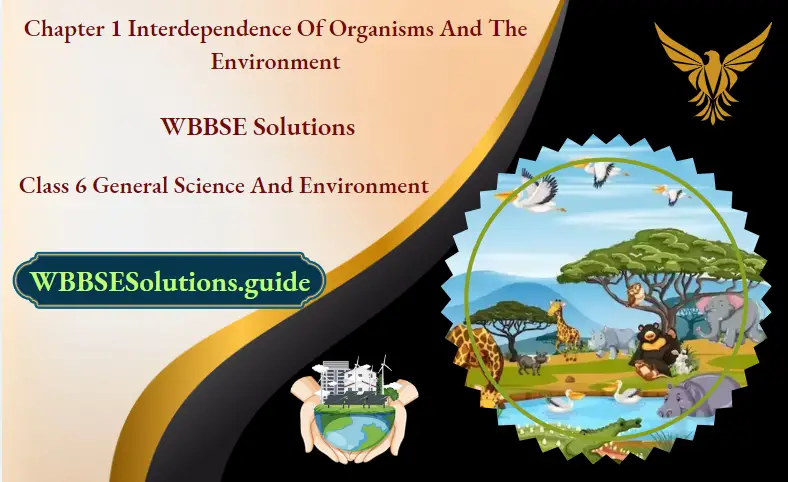
Carnivorous
The animals that feed on other animals Example Tiger, Lion, etc.
Herbivorous
The animals eat only plants example cows, Buffalo, Deer They, etc.

Herbivorous animals like cows, deer, goats, sheep, elephants, etc. depend upon plants directly for their food. For example, when we take guava as food, we take plant products directly.
But when we take a boiled egg or a glass of milk or a piece of meat as the food we are indirectly taking plant products as the hen (for egg) or cow (for milk) or goat or sheep (for meat). respectively who collect their food directly from plants.
Therefore, all animals depend on plants for food either directly (herbivores) or indirectly (carnivores)

Make a list of animals who depend upon plant/plant products directly. (Complete the table.)
| Name of the animal | Plant/ plant parts | Other sources (animals) | Nature |
| 1. Cow | grass, different plant parts leaf, stem, fruit, flower, etc. | not taking animals’ food | totally depend upon plants (herbivorous) |
| 2. Goat | ……………….. | ……………….. | ……………….. |
| 3. Hen | Grass, young leaves | small insects earthworm etc. | depend on both plant and animal (omnivorous) |
| 4. Snail | ……………….. | ……………….. | ……………….. |
| 5. Monkey | ……………….. | ……………….. | ……………….. |
| 6. Deer | ……………….. | ……………….. | ……………….. |
| 7. Lion | ……………….. | ……………….. | (Carnivorous) |
Make a list of animals who take plant/ plant products indirectly.
| Animals | Animal food sources | Plant food sources of consumed animals | Nature |
| 1. Tiger | Dear, cow, hare, goat, etc. | Grass, different plant part | Carnivorous |
| 2. Kite | – | – | – |
| 3. Fox | |||
| 4. Pea-cock |
Insectivorous plants
Pitcher plants, trap insects and use them as external sources of food of animal origin.
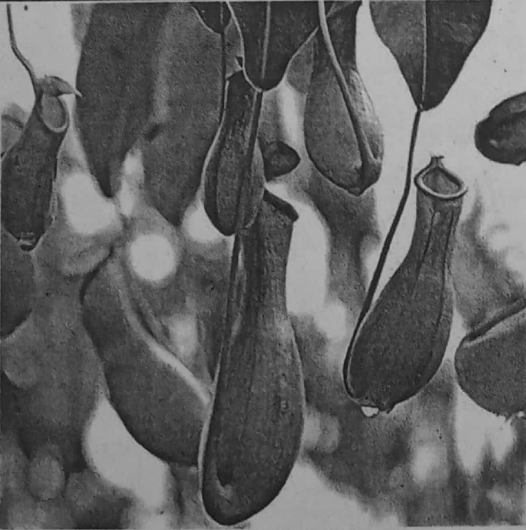
Human Beings depended a lot upon plants. let’s complete the table below. Here different plant parts have been mentioned.
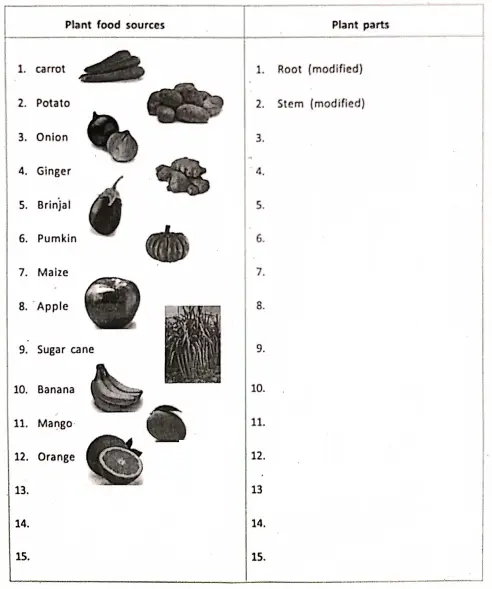
Chapter 1 Interdependence Of Organisms And The Environment Use Of Plant Parts Other Than Food By Animals
Dependence of animals on plants to build their homes:
Mostly birds build their nests on the trees, but some other animals such as mammals, arthropods, and reptiles also use trees as their home. Weaver birds (such as Baya weaver) are specialized to use leaves and twigs and build fine nests.
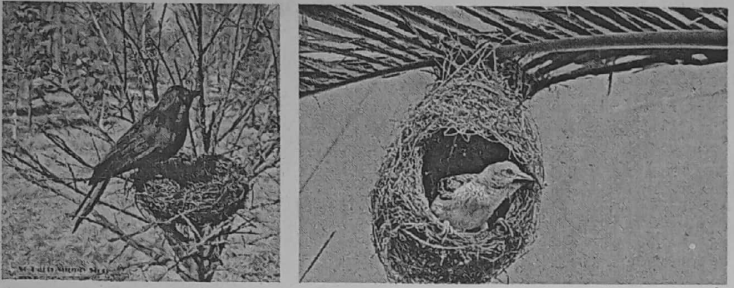
But all of the birds are not able to do so efficiently, they build nests with plant parts like twigs, dry grass leaves, and with other substances (e.g. crow). Some birds like parrots, wood pickers, and owls live inside the cavity or holes of trees.
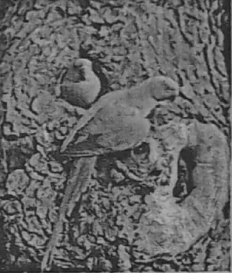
Nest:
A bird nest is a place in which a bird lays and incubates its eggs and raises its young.
Some birds are unable to build their nest in trees but build nests in the rooks and corners of houses, in the cornices or many places using different plant parts. (e.g. Sparrow) Herrons and some sea birds build platform nests.
“Class 6 WBBSE General Science Chapter 1 interdependence of organisms explained”
Platform nests are large flat nests built in the tree top. Vulture builds their nest high on the branches of Banyan (Bath), Peepal, and Raintree. Some tree dwellers are Spider, Monkeys, Tree kangaroos, Orangutans, Sloth, etc.
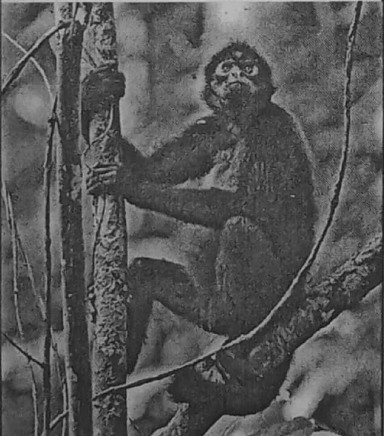
Squirrels, Spiders, Ants, and many other insects, also live on trees. Bats hang from the branches of trees. Many birds also stay, their night and resting period on the plant.
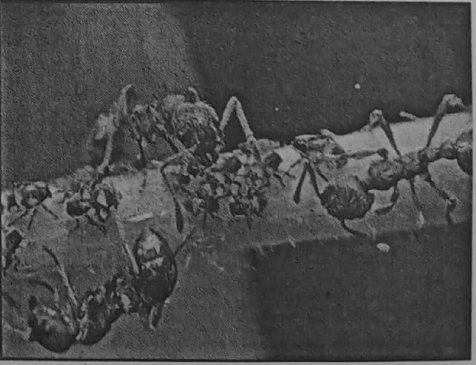
Observe your locality, school, playground, park, bushes, and forest (if you have a chance to visit).
Complete this table on how birds and other tree-dwellers build their nest using different plant parts.
| Different plant parts | Animals | Nature of nest | Tree |
| Example 1. Twigs, leaves | Weaver Bird (Babui) Baya weaver | Hollow fine flask-shaped narrow tube-like nest | Palm, Coconut |
| 2. Dry twigs, grass leaves, and other substances | Crow | Pot-like, irregular build-in horizontal branches | Mango, Jam, etc. |
| 3. | |||
| 4. | |||
| 5. | |||
| 6. |
Chapter 1 Interdependence Of Organisms And The Environment Use Of Plant Parts For Building Our House
Have you seen any wooden houses? If you go to any hilly areas or earthquake-prone areas you will find this type of house. The frame of the house, floor, roof, beams, and side walls all are made of wood. You may also notice heavy wooden frames in the ceiling.

Farmers are habituated to use wooden equipment from ancient times during cultivation, such as Plough, Mai (ladder), etc. Boats, traditional ships (in ancient times) wheels of bullock carts, and chariots, (two-wheeled vehicles pulled by horses) are also made up of wood.
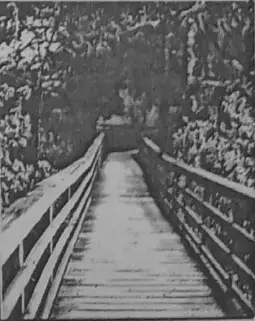
Most of our household furniture such as chairs, tables, beds, and almirah are also made up of wood. In some remote places, temporary bridges are also prepared with bamboo and wood.

Make a list of wooden articles and their sources (plant parts) and uses.
| Wooden articles | Source/plant/ plant parts | Uses |
| 1. Boat | 1. Tree trunk-wood | 1. Use as a vehicle In the water. |
| 2. ……. | 2. Tree Trunk | 2. …… |
| 3. ……. | 3. ……. | 3. a Sitting arrangement of students in classroom. |
| 4. ……. | 4. …… | 4. …… |
| 5. ……. | 5. …… | 5. …… |
Use of Plant Parts:
| Plant Parts | Name/Type of plant | Use of the part | Remarks |
| Example | |||
| 1. Fruit | Bel-tree | Food, as well as medicine | Other parts are also used, such as leaves, twigs wood. |
| 2. Leaf | Palm-tree | Hand fan | Other uses chatai (Mat) |
| 3. Seeds | |||
| 4. Trunk | |||
| 5. Flower | |||
| 6. Gum (Latex) | Rubber | Eraser, car tires | Prepare from an excretory product of plant (latex). |
| 7. |
Chapter 1 Interdependence Of Organisms And The Environment Our Dependence On Plants For Our Clothes
Most of you have seen a charka printed in Indian currency. Do you know what its use is? If you observe it carefully you will see charka pullar making fine threads from the cotton balls (karpas).
These threads are used to prepare clothes. If you visit any handloom weavers’ house you will find how these threads are used to form a piece of cloth. If you carefully observe a thread you will see threads are made up of fibers.
“Step-by-step notes on interdependence of organisms and environment Class 6 WBBSE”
There are many fibers yielding plants in nature, such as karpas, simul, Jute, etc. Cotton fibers are used to make cloths from which we make our dress materials.
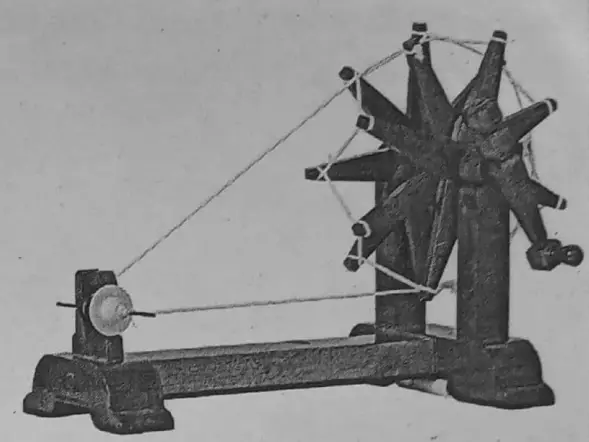
Though nowadays artificial fibers are also used to prepare dress materials but dress-materials made up of cotton are comfortable and health-friendly.

Karpas threads are also used to prepare bags, ropes, and many other household goods, simul cotton (silk cotton) are used to prepare pillow, and mattresses and also use in medical purpose.
Jute and Coconut fibers are also used to prepare sacs, rope, and other goods. Nowadays use of jute and coconut fibers has been declined. Artificial fibers are used in place of that, these increase the chance of pollution.
Complete the table.
| Name of the fibre-yielding plants | Parts of the plant used is fiber | Use of it | Remarks |
| 1. Karpas | Fibers around the seed | Cloth, dress-material preparation | Comfortable and health-friendly dresses |
| 2. Shimul | ……… | ……… | ……… |
| 3. Jute | ……… | ……… | ……… |
| 4. Coconut | ……… | ……… | |
| 5. | ……… | ……… | |
| 6. |
Chapter 1 Interdependence Of Organisms And The Environment Other Products Of Plants Which We Often Use
So far from the discussion, it has been found that we depend upon plants for food, clothes, shelter, and many other different objects used in everyday life.
But this is not the end there are so many other things we get from plants. The book you are now reading, and the paper on which you write all are plant products. The glue (gum) you use are also a plant product(though nowadays synthetic glue are also used).
Excretory products:
Waste matters produce during metabolism in the body example resin, latex, tannin (plant) urea, and uric acid (animal).
Alkaloid:
Nitrogenous excretory products of plant e.g. quinine, reserpine.
“WBBSE Class 6 General Science Chapter 1 important questions and answers”
Resin:
Excretory products of plants are used to polish wooden furniture. It makes our furniture glossy and beautiful, as well as protects wooden furniture from water (water proof).
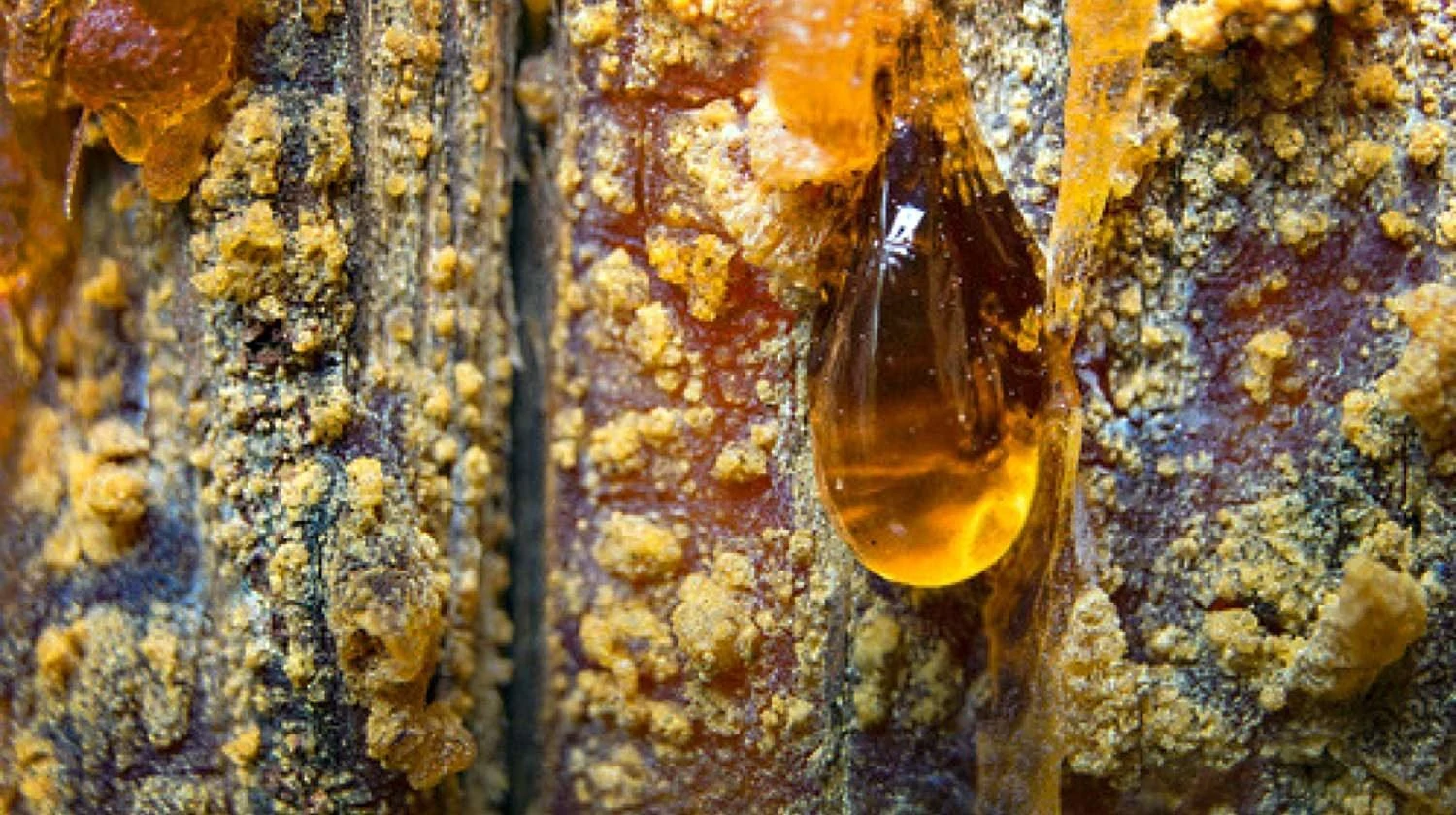
Most of you have heard the name of Quinine, it is also an excretory product (alkaloid) of the Cinchona plant used as effective medicine of Malaria. Many such plant products are used as medicine, such as products of Tulsi, Swarpagandha, Basak, etc.
List of plant products used as medicine
| Plant products | Parts of Plant | Use |
| 1. Quinine | The bark of the plant Cinchona | Effective medicine of Malaria |
| 2. …….. | …….. | …….. |
| 3 …….. | …….. | …….. |
| 4 …….. | …….. | …….. |
Chapter 1 Interdependence Of Organisms And The Environment We Get Oxygen From Plant
You have learned already that man as well as other animals inhale oxygen (O2 ) and exhale carbon dioxide (CO2 ) during respiration. Plants consume carbon dioxide (CO2 ) of the atmosphere during food preparation (photosynthesis).
The process of food preparation of green plants (chlorophyll-containing) with carbon dioxide and water in the presence of sunlight is called Photosynthesis.
During this process, plants give off (liberate) oxygen.
So these two processes photosynthesis (by plants) and respiration (by all organisms) balance atmospheric oxygen and carbon dioxide.
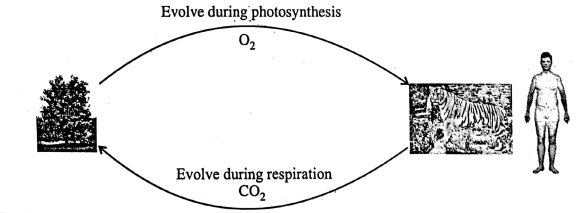
From plants, only oxygen (O2 ) is liberated during day time though plants to take oxygen (O2 ) for respiration. But the amount of O2 produced during photosynthesis is higher.
So, the green plants get their necessary oxygen for respiration from their own system and liberate excess O2 to the atmosphere during the daytime.
The amount of CO2 liberated during respiration also use by plants for photosynthesis, but not during the night (because photosynthesis does not occur during the night.)
Chapter 1 Interdependence Of Organisms And The Environment Dependence of Plants On Animals
Pollination:
While moving in the park or in the garden you may have seen bees, butterflies bumble bees or some other insects who are moving from one flower to another (fluttering among flowers). Are they playing? No, they are in search of their food (honey or nectar).
Their movement from flower to flower benefited plants. These insects transfer pollen grains which are attached with their legs, wings, and mouth parts from one flower to another. They act as a vehicle.
“Solved examples of interdependence of organisms and environment WBBSE Class 6”
This process of transfer of pollen grains from flower to flower is known as pollination. Pollination leads to fertilization. The process of union or fusion of pollen grain (male gamete) and ovum (female gamete) starts the production if seeds. It is essential for the creation of new plants.
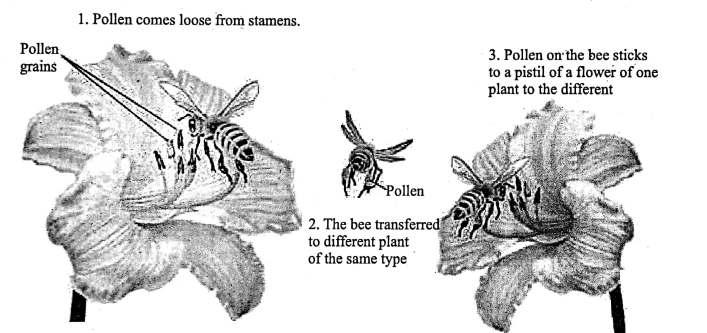
Pollination:
It is the process of transfer of pollen grains from the anther (male part) to the stigma (female part) of a flower. When the pollen grain are transferred within the same flower or other flowers of the same plant is called self-pollination.
The pollen grains can be transferred from the flower of one plant to the flower of different plants of the same type. This is called cross-pollination.
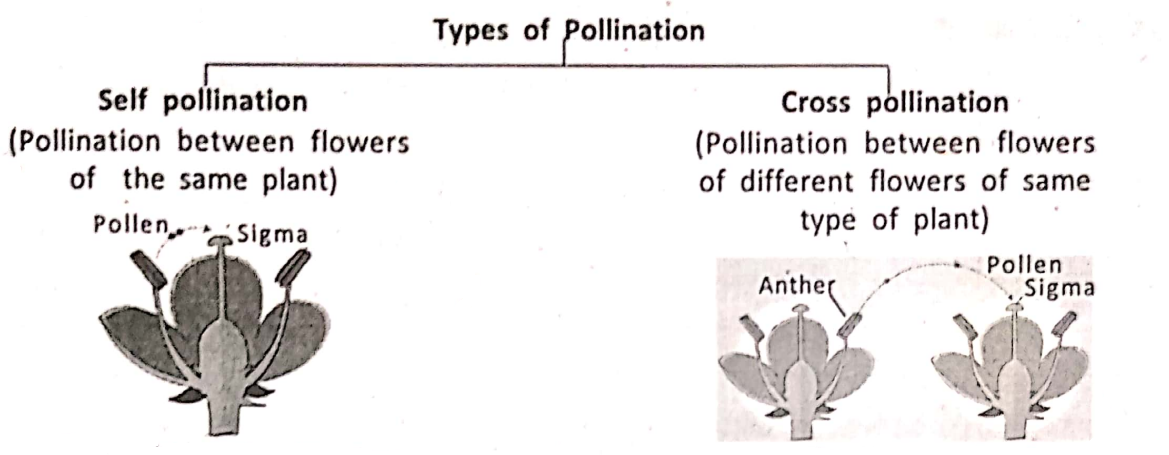
Agents of pollination:
Those who help in pollination are known as agents of pollination these are insects (bees, butterflies, ants, etc.), birds, reptiles, bats, man (biotic agents), wind, water (abiotic agents), etc.


Complete the table
| Pollinating agents | Examples |
| 1. Wind | 1. Paddy, Maize |
| 2. Water | 2. Vallisnarla |
| 3. Bee | 3 …………… |
| 4. Birds | 4 …………… |
| 5 …………… | 5 …………… |
| 6 …………… | 6 …………… |
| 7 …………… | 7 …………… |
| 8 …………… | 8 …………… |
Chapter 1 Interdependence Of Organisms And The Environment Dispersal Of Fruits And Seeds
Many of you have noticed that Banyan or Peepal trees grow in the narrow fold of concrete walls or in the carnies or in the corner of the roof.
How does this happen?
This is due to the dispersal of fruit and seeds of these plants. Seeds of these plants are brought to this unusual location (where no or little soil content) may be by wind, water or most cases by birds.
Birds often fly with fruit or seed in their breaks, sometimes these fall to the ground or other places. Sometimes birds drop partly eaten fruit, seeds may also be transferred through the feces of birds.
Bats and some other mammals (dogs, foxes, etc.), also transfer seeds through feces. Undigested or partly digested seeds of feces germinate in favorable conditions.
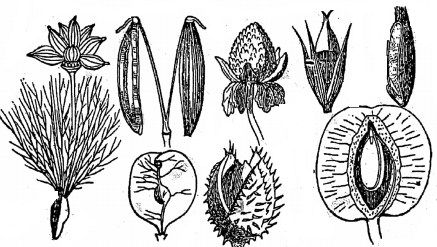
Many of you after coming from the playground or park pick some sharp stick-like things from your dress, which are attached with your dress, and threw it outside. You may have also noticed your mother or sister also doing this after Coming from the park.
These are seeds of grass or other plants. This is one of the ways of dispersal of seeds. Many fruits and seeds have some adhesive substance or some plants have sticky seeds or some fruits and seeds have special devices like hooks and thorns by which are attached with animals’ bodies and transfer from one place to another.
Some seeds are so light and have a wing or fiber-like structure that helps them to float in air for a long time and can move from. one place to another by air.
Fruits and seeds after ripening usually go away from their parent plants to be distributed so as to develop their families in a larger scale with the least competition.
There are a variety of ways to disperse of seeds in nature-wind, water, animals, and sometimes special devices such as utilizing explosive force to spread their seeds away (e.g. Dopati).
Humans consciously or unconsciously take part in the dispersal of fruits and seeds. Such as when you through a mango or Jamun seed after eating its soft food part to ground.
Complete the table
| Agents that help in the dispersal of fruits and seeds | How this happens |
| (A) By animal | (A) |
| 1. Rat | 1. …………. |
| 2. crow | 2. …………. |
| 3. Fox | 3. …………. |
| 4. Wild cat | 4. …………. |
| 5. Man | 5. …………. |
| (B) Wind | (B) …………. |
| (C) Water | (C) …………. |
| (D) Plant, Own device | (D) …………. |
Chapter 1 Interdependence Of Organisms And The Environment Nature Of Relationship Between Different Organisms
You may have noticed the presence of many red ants in ‘Jam’ (Black plum) and ‘Jamrul’ (water rose apple) trees especially during summer when’ these plants bear fruits (Jam and Jamrul).
It will be difficult for you to collect fruits without experiencing any bites of the ants. These ants protect the plant and fruits in exchange they get food and shelter from the trees.
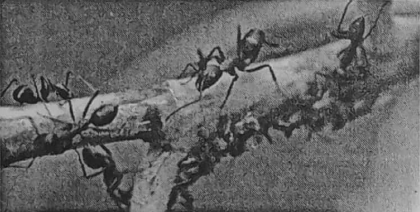
Different organisms of different populations do not live in isolation from one another. They are dependent on one another for food, reproduction, dispersal, space, and protection.
In nature, we can often see relationships between two organisms. Sometimes both are dependent on each other for their survival such as in Lichen, an organism which is an association of blue-green algae and fungus.
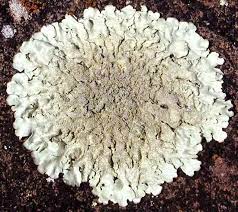
The fungus helps in the absorption of water and minerals and the algal partner manufactures food. Both of them share this food.
In some relationship, one organism of two different types of organisms (species) is benefits, while the other remains unaffected. The organism which is benefited is called commensal and this incident is known as commensalism.
Example:
Arctic fox follows seal while Jackals follow Lion and Tiger they feed on the leftovers.
Symbiosis (or Mutualism):
When two or more organisms survive and benefited in nature by helping one another. This type of beneficial relationship is called symbiosis.

Example of Symbiosis :
Rhizobium, nitrogen-fixing bacteria form nodules in the root of leguminous plants such as peas, grams, beams, etc. Rhizobium fixed nitrogen and forms a nitrogenous compound which are shared by both. Plants give shelter and allow the Rhizobium to form nodules.
Some of you may have seen during the cultivation of paddy farmers use a reddish-green small plant, Azola in the field. This plant helps to increase production.
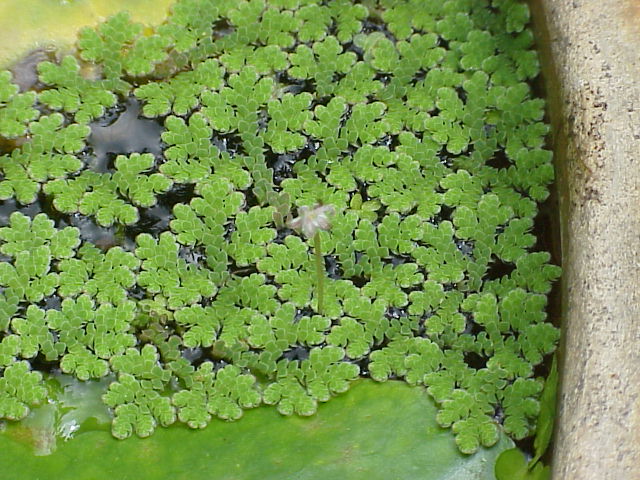
Azola a tiny aquatic plant (Fern) reddish-green in colour whose leaves contain nitrogen-fixing cyanobacteria (Anabaena azollae). This is a symbiotic association between them. Anabaena can capture atmospheric nitrogen.
Azola gives them shelter. Azola is used in the paddy fields as a biofertilizer (natural manure). Therefore, no need to add additional nitrogenous manure in the field.
Chapter 1 Interdependence Of Organisms And The Environment Few Examples Of Symbiotic Relationships
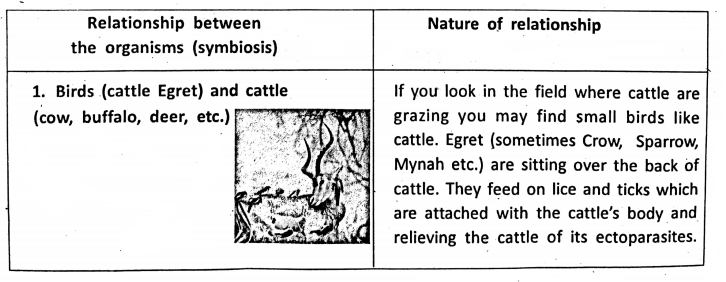
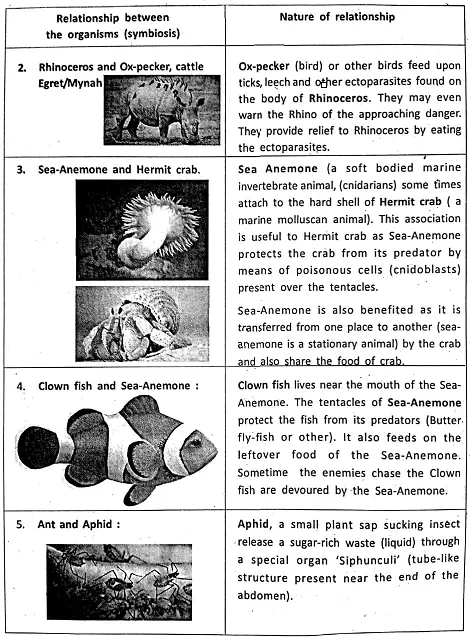
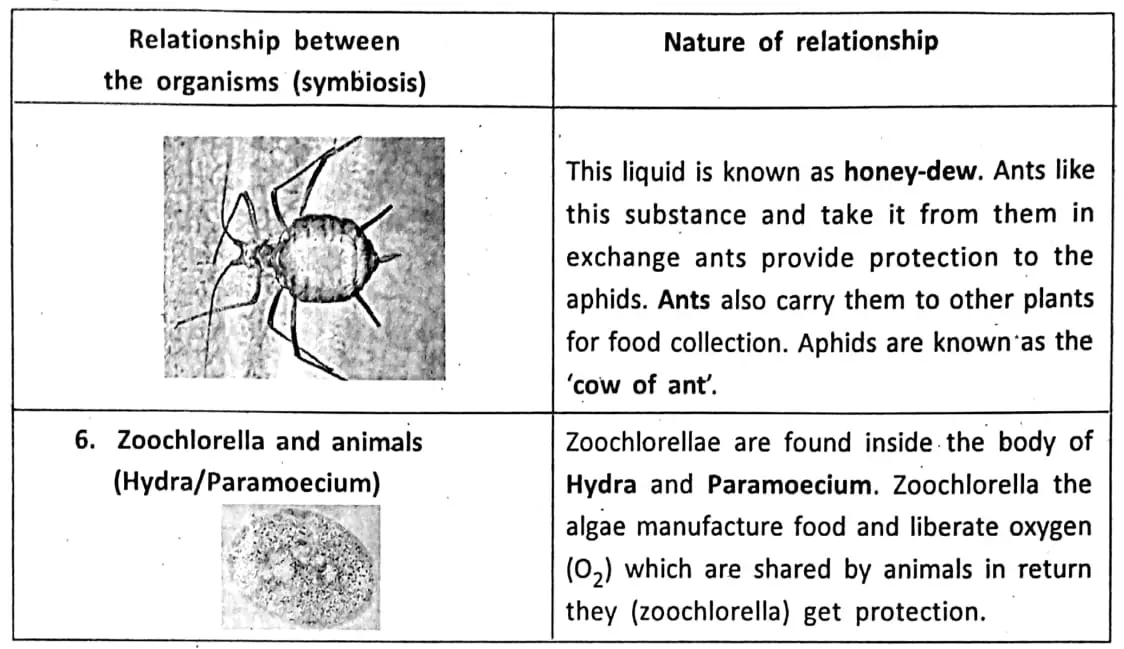
Chapter 1 Interdependence Of Organisms And The Environment Animals Eat And Being Eaten Who Eats Whom
If you are asked what things cows, goats, deer, and buffalo use as food-all of you have the ready answer. They eat plant materials. The animals who eat only plants are called herbivores (herbivores) on the other hand the animals who eat other animals are called carnivores (carnivores).
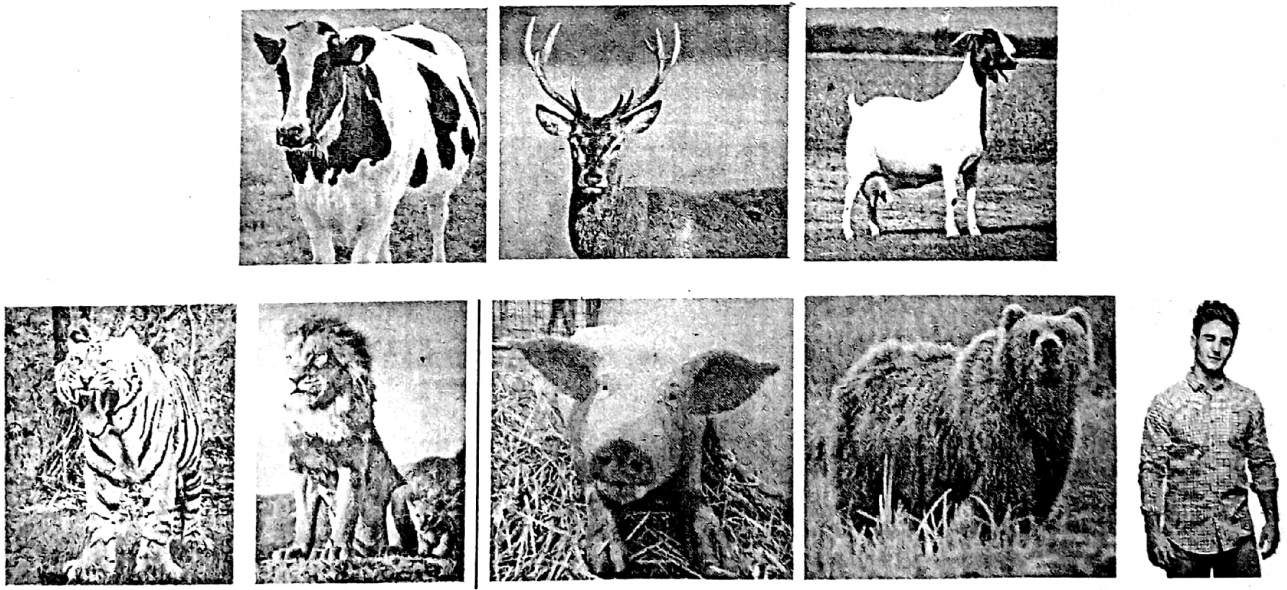
Herbivorous herbivores :
Herbivores are animals who eat only plants example cows, Deer, goats, etc.
Carnivorous/carnivores:
The animals mostly eat meat or the flesh of animals example tigers, lions, etc.
Omnivorous (omnivores):
Omnivore is an animal that eats either animals or plants or both example pigs, bears, men, etc.
If you observe carefully in nature one animal eats another and himself becomes the prey for some other animals.
Predator and Prey:
Tiger eats deer. Here tiger is called the Predator and the deer is called the Prey. The organism which does the act of capturing, killing, and eating another organism (animal) is called a predator.
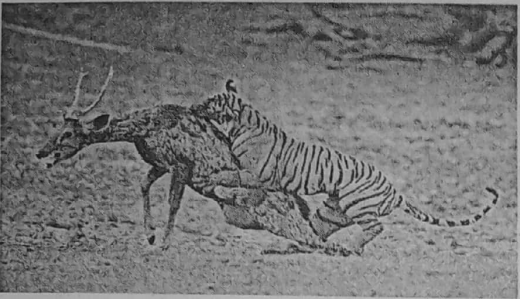
On the other hand, the organism which is being killed and eaten is called the prey. See another example- A toad eats insects. They (toads) are being eaten by snakes. The snakes become the food of eagles or peacocks.

Predator and Prey (relationship):
Examples:
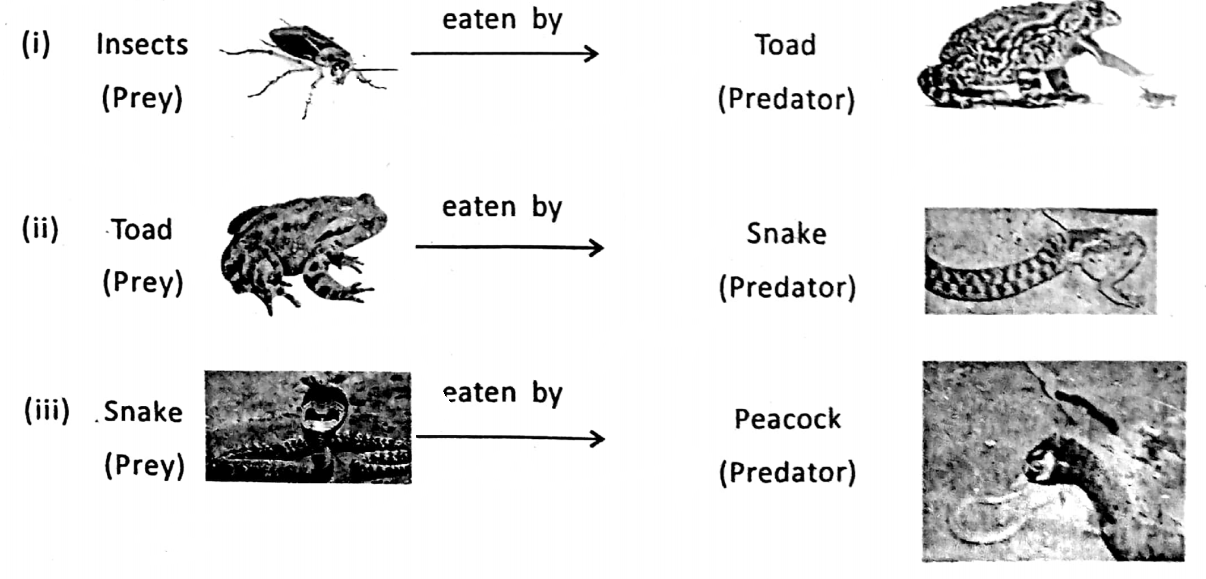
Make a list of animals of herbivores, and carnivores :
Prey and Predator
| Animal | Nature | Where you have seen | What docs it cat (Prey) | Predator |
| 1. Deer | Herbivorous | Forest, sanctuary or zoological garden | Grass, plant-parts | Tiger, Lion (carnivores) |
| 2. Monitor Lizard | Carnivorous | Grass-land near pond, Lake, river, forest, bushes | Snake, “crocodiles gg, fib., rat, ground birds, and their eggs | Big animals like Python etc. |
| 3 …………… | 3 …………… | 3 …………… | 3 …………… | 3 …………… |
Chapter 1 Interdependence Of Organisms And The Environment Parasitism
Living on others and taking food from it.
Have you seen Leech attach with the body of a cow or buffalo? Have you seen lice, tiny brownish insects present in the hairs of a human head. Leech and lice both suck blood from which organisms they attack, these animals are called parasites.
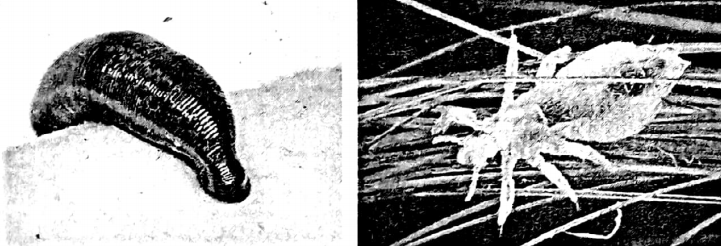
The organism that feeds on another living organism without killing it (doing harm to the host) is called a parasite (for example. a bed bug). The parasite is harmful to the host (from which the parasite collects food).
Host:
The host is the organism from which the parasite obtains nourishment.
Parasite:
The organism (usually smaller than the host) obtains nourishment from a larger organism called the host and spends a part or whole of its life on or inside the body of the host is called a parasite. example Lice (animal), Swarnalata (plant).
| Temporary parasite | Mosquito (Anopheles, Culex) |
| Permanent Parasite | Human louse (external) Tapeworm (Taenia) (internal) |
| Ectoparasite | Leech, Bed bug. |
| Endoparaslte | Plasmodium. Taenia |
Complete the table :
List of a few parasites and their location and the harm they cause.
| Parasitic Organisms | Host | Location (Where it lives) | Harmfulncss (How It harms the host) |
| 1. Tuberculosis bacteria (TB) [Mycobacterium tuberculosis) | Man and some other mammals | Lung, Bones, Lymph nodes, etc | Causing Tuberculosis (TB) —fever, cough, weakness, weight loss, late-stage blood in the cough. |
| 2. Tape worm [Taenia solium) | Man, pig, cow, etc | Intestine, stomach, brain, muscle cells | Weakness, seizure, anemia. |
| 3. Malarian Parasite (Plasmodium) | Man | RBC, (Blood cell), Liver | Fever, weakness, anemia enlargement of liver and spleen.’. |
| 4. Amoeblosis [Entamoeba histolytica) Protozoan microbes | Man | Human intestine | Diarrhea, dehydration, (loss of body water) pain in the lower intestine, mucus in the stool (mucousy stool) |
| 5. Typhoid | |||
| 6. Dengue |
Swarnalata (Cuscuta)
A yellowish filamentous (wire-like) creeper plant that surrounds different areal parts of plants and sucks the juice from the host plant (by haustoria).
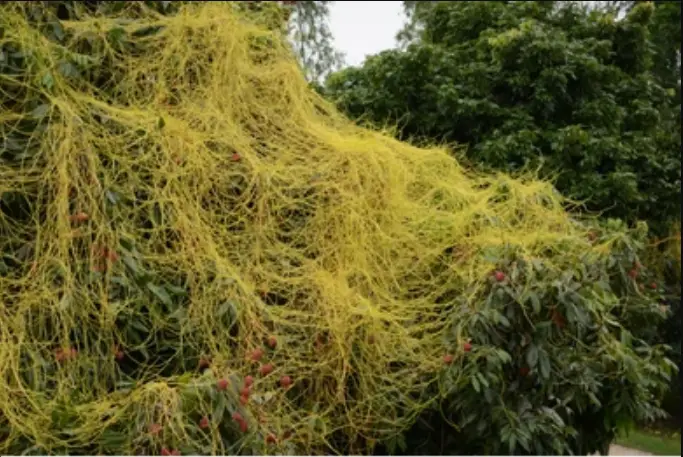
Dependence Of Man On Animals
Many of you have experience of taking the juice of ‘tulsi’ or ‘Basak’ or ‘kalmegh’ leaves mixed with honey as ayurvedic medicine. Honey is a sweet viscous fluid obtained from a honeycomb prepared by the honey bees.
Chapter 1 Interdependence Of Organisms And The Environment Honey Is A Mixture Of Nectar Pollen And Saliva Of A Honey Bee.
Like honey we use many products of plants and animals as food, medicine, dress material, and other purposes, Humans are benefited from the animal world in many ways since the dawn of civilization.
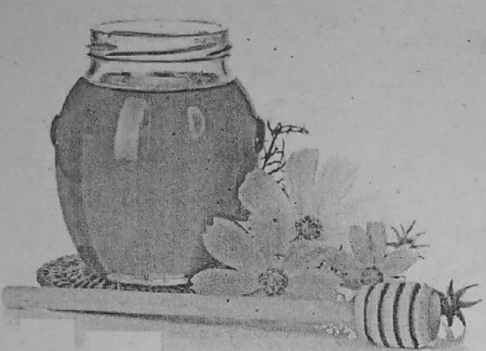
On the basis of utility animals can be grouped in the following types
1. For food
- We get milk from cows, buffalo, goats, sheep, etc.
- We get meat from fowl, ducks, goats, sheep, cows, buffalo, pigs, etc., and eggs from birds.
- We also get some bi-products from animals such as butter, ghee, panir, loss, etc.
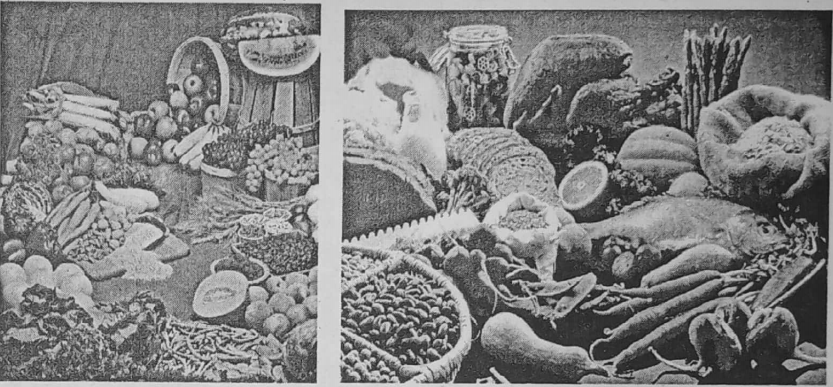
| Products | The animal from which we get it |
| 1. Milk | |
| 2. Meat | |
| 3. Honey | |
| 4. Egg | |
| 5. | |
| 6. |
2. Animals used in preparing to clothe
Many of our dress materials like ‘sari’, shart, ‘dhuti’, and many others are made up of silk beside plant products- cotton. Silk is a hard, shiny, fine thread extracted from the cocoons of silk-moth. Silk moth is a tiny insect (Bombyx mori).
We get laksha from insects, and silk from silk moths (insects). Warm clothes are prepared from wool. Wool prepare from the body hairs of sheep and some other animals.
Dress material- animal sources
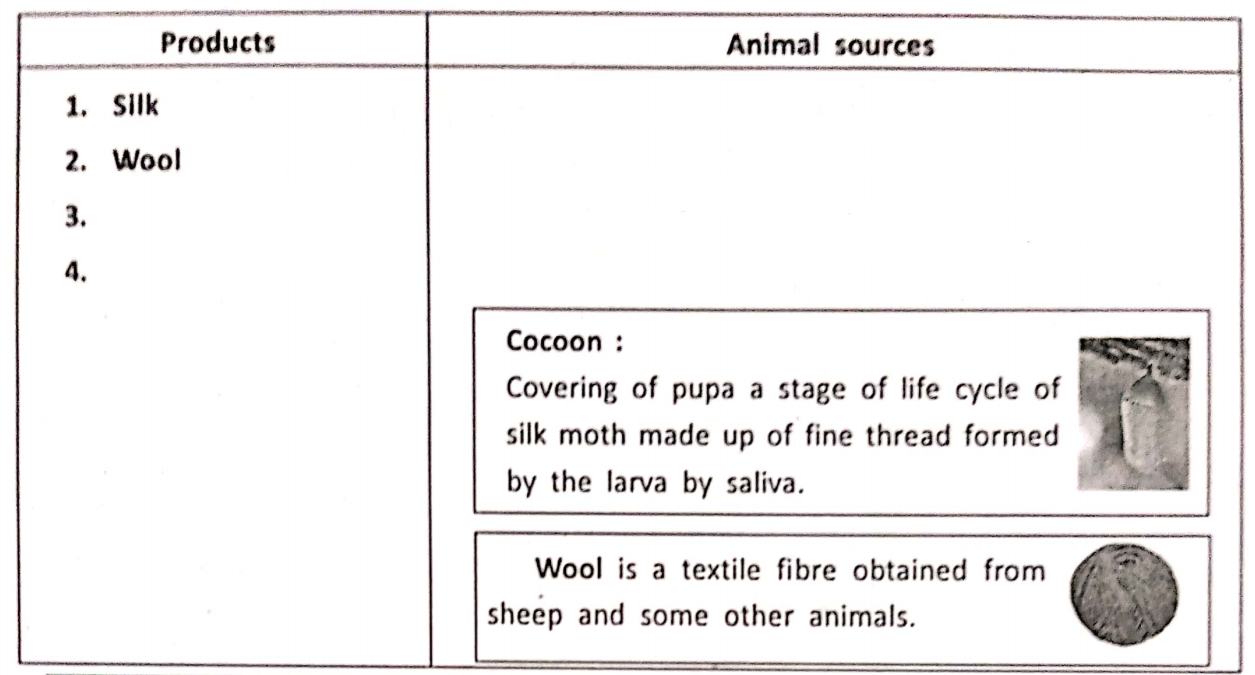
3. Animals are used in producing medicine
You may have seen cod liver oil. It is used to massage the whole body of a baby and adult. This is good for skin and bone as it contains a good amount of vitamins A and D.
Sometimes Doctor (physician) prescribes some tablets (medicine) made up of liver oil extracts (Fish like shark, cod, Halibert liver oil) which are rich with vitamins A and D. These vitamins make our bones and teeth strong.
“Best guide for Class 6 General Science WBBSE interdependence of organisms”
Vitamins are components of our diet present in very small amount though it has no calorie value but it protects our body and maintains growth. Deficiencies of vitamins cause many problems of our bodies.
Vitamins are A, D, C, E, and B-complex. We eat ‘mate’ of meat. This is the liver of that animal.
| Name of the medicine of animal origin | Animal from which its obtained | Use of it |
| 1. Cold-liver oil capsule | 1. | 1. |
| 2. Antivenom (antivenin) | 2. | 2. Used to treat Venomous snake bites |
| 3. | 3. | 3. |
| 4. | 4. | 4. |
4. Role of Animal in pollution control/Animals that help in reducing pollution
All of you have noticed that crows eat dead and decaying substances from the roadside or uncleaned dustbins where waste materials are dumped. You may have also seen vultures (birds with ugly long hair and fewer necks) that eat dead and decaying animals.

These birds keep clean our environment. Crow is called a sweeper bird as it cleans our environment.
| Name of the Animals reducing pollution | How the animals work | Remarks |
| 1. Vulture | 1. Tree trunk-wood | 1. |
| 2. Crow | 2. | 2. |
| 3. Owl | 3. | 3. |
5. Animals that help in transportation
Some of you may have the experience to ride on bullock carts. From the old ages bulls, buffalo, camels, and horses are used to pull carts in remote places as well as in some urban areas.
These carts are used to carry passengers as well as goods from one place to another. Donkeys, horses, camels, and elephants are also used to carry people as well as goods where regular vehicles are usually not available.

Rain Deer (in Scandinavian countries), dogs are used in the polar regions particularly in the Arctic circle to pull the ‘Sleigh carts’, which carry goods and polar people. Horses are used since the ancient period for the speedy transport of persons, especially to send messages in the battlefield.
| Name of the animals that help in transport | Types of Carriage | Nature of carriages |
| 1. Horse | ||
| 2. Bullock-carts | ||
| 3 | ||
| 4 |
6. Animals that help in Agriculture
If you go to the village side during the rainy season you may find some small farmers are still using bullocks for plowing. Though nowadays tractors or other new machines are used in a large scale.
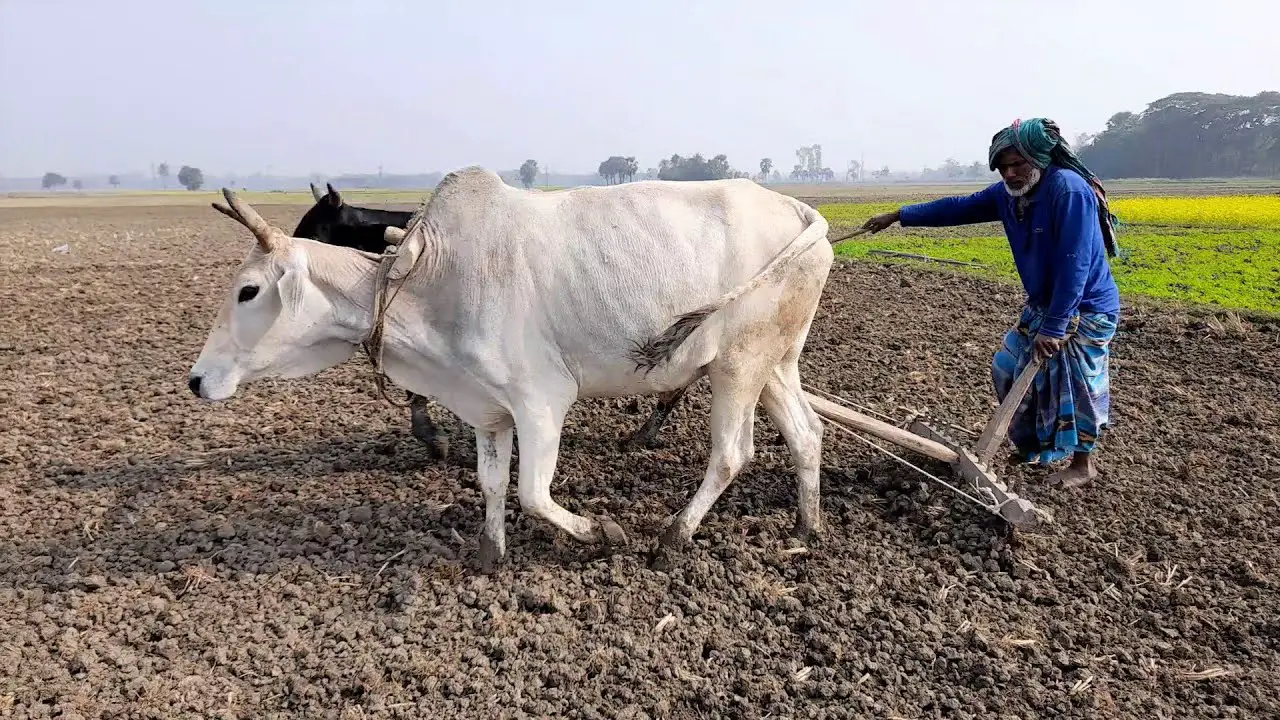
Bullock, camel, buffalo, horse, and donkey are also used to separate grains from crop plants.
| Name of the animal | How the animals are used in agriculture | Remark |
| 1. Bullock (Ox) | Plowing, pulling leveler to leveling the uneven agricultural field. | Small farmers use them to cultivate small areas, (nowadays tractors are usually used in this purpose) |
| 2. Horse | – | – |
| 3. Camel | – | – |
| 4. Donkey | – | – |
Chapter 1 Interdependence Of Organisms And The Environment Use Of Microbes In Human Welfare
Microbes we depend upon :
If you follow the process of curd preparation at home or in the sweet shop you will see a small amount of card as inoculum (saja) are added to milk during the preparation of new curd and under a suitable temperature this curd-mixing milk turns into curd.
Why does this happen? A type of microbes known as Lactobacillus is responsible for curd formation. With the transfer of old curd millions of Lactobacillus, microbes transfer to milk. These microbes (LAB) grow in milk and convert it into curd.
“Understanding ecosystem and interdependence of organisms Class 6 WBBSE”
Lactobacillus is commonly called lactic acid bacteria or LAB. The organisms which are not visible with the naked eye are viewed under a microscope only and are called microbes.
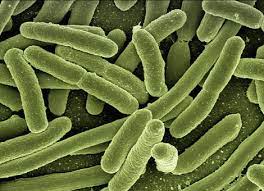
Like curd, the dough which is used for making ‘dosa’ and ‘idli’ is also fermented by microbes (bacteria). A number of traditional drinks (‘hanria’, mohua, etc) and food are also made by fermentation.
Fermentation is the process in which a substance mainly sugar (carbohydrates) breaks down into simpler substances (alcohol or any organic acid) Microorganisms (microbes) like yeast (fungus), and bacteria usually play role in the process.
Yeast :
Single-cell fungus Scientific name-Saccharomyces cerevisiae
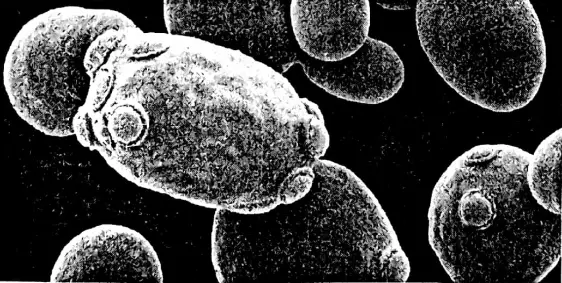
Steps of making curd (Complete the table)
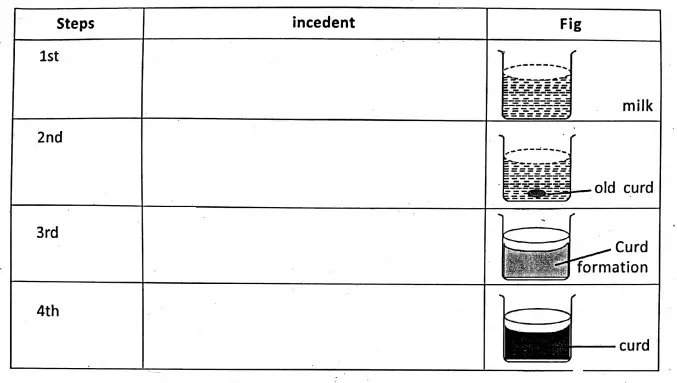
Preparation of bread :
Most probably all of you have seen bread and experienced its test. Do you know how this soft, porous food prepare? Bread is made up of flour, water, and a little bit of sugar.
During its preparation ‘yeast’, a kind of single-cell fungus is mixed with the dough (flour, water, and sugar mixture). Yeast helps to ferment the dough. During fermentation carbon dioxide (CO2 ) and alcohol are produced.
CO2 helps in swelling dough. During breaking CO2 comes out, thus pore is formed in the bread.
Preparation of medicines :
Nowadays many of you are familiar with the term antibiotics. If you go to a medicine shop you will find different types of antibiotics. Sometimes doctors prescribe antibiotic medicines to cure certain diseases.
Antibiotics are chemical substances that are produced by some microbes (bacteria, fungus) which can kill or retard the growth of other disease-causing microbes. Many of you are familiar with the drug penicillin, a commonly used antibiotic. Penicillin is prepared from penicillium-a fungus
Nowadays scientists are able to prepare many antibiotic medicines (antibiotics) from different microbes. Streptomyces is the largest antibiotic medicine-producing microbes (bacteria) (antibacterial, antifungal, antiparasitic medicine).
“WBBSE Class 6 Science environment and organisms relationship notes”
Many of its products are applied in humans and are used as veterinary medicine, agriculture, as well as antiparasitic agents. Erythromycin and Streptomycin have commonly used antibiotics derived from streptomyces.
Complete the Table :
